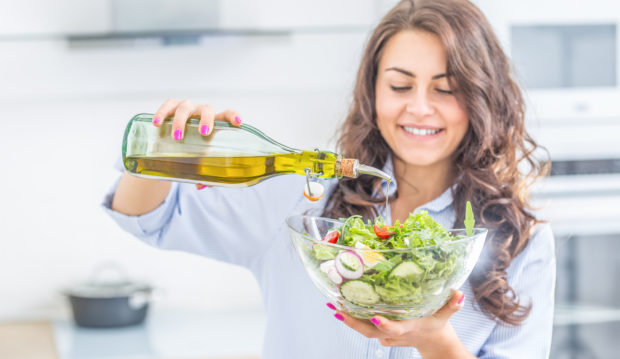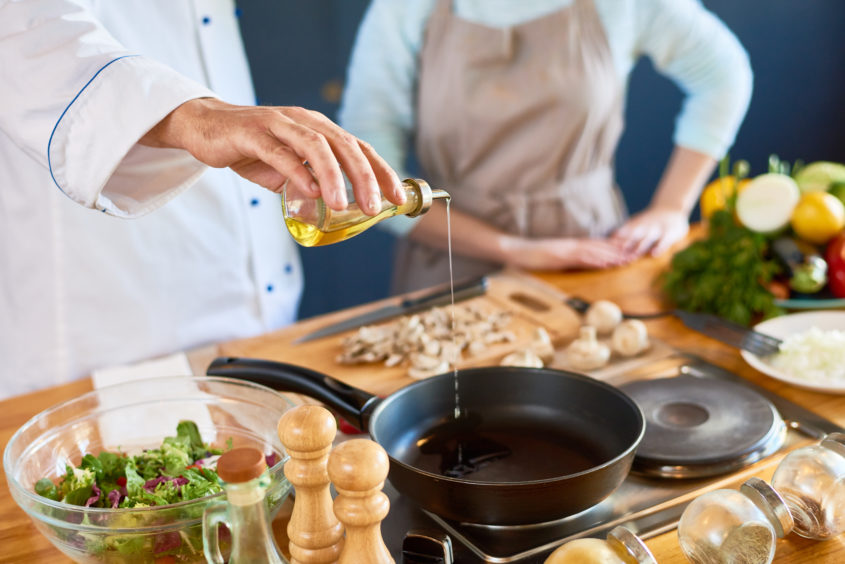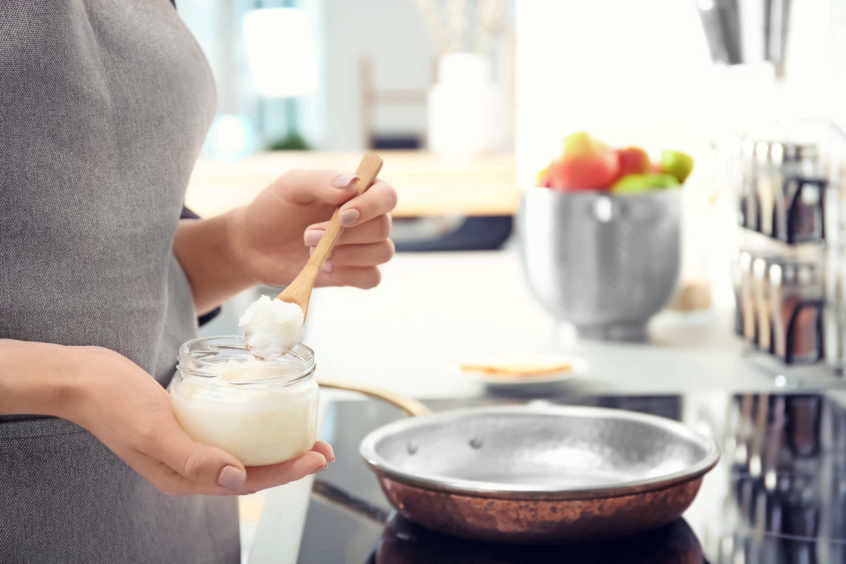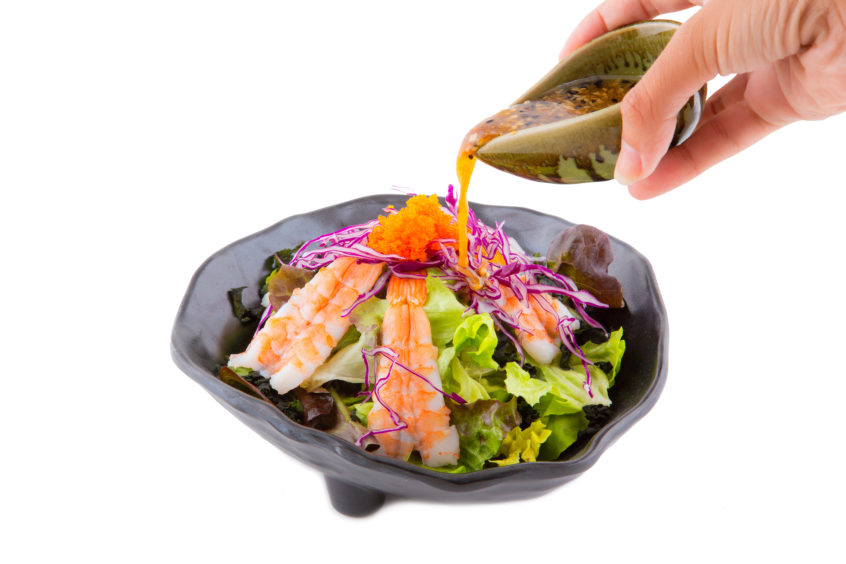Two nutrition experts talk Nadia Vidinova through the science behind the bewildering array of cooking oils on the market and how best to use them.
Just a generation ago, the choice of what type of fat to cook with was simple. There was lard, butter or vegetable oil, and if you really wanted to push the boat out you could opt for the exotic-sounding olive oil.
These days supermarket shelves are creaking under a vast range of cooking oils, some sold cheaply in large plastic bottles while others sit in dinky artisan containers and come with a hefty price tag.

We’ve never been more spoiled for choice – or more confused.
If labels are to be believed, each product boasts endless nutritional benefits and is better than the next, while the advice from scientists and health professionals is often contradictory.
So which oil is the healthiest? Unfortunately, there isn’t one clear-cut answer.
The best option for you will depend on how you intend to use the product, how it’s been manufactured and your overall diet.
Dr Sarah Cottin, lecturer in nutritional sciences at Abertay University and Beverley Sarstedt, nutritional therapist at Nourishing Insights in Aberdeen, are on hand to untangle the science behind some of the most popular oils and health claims, to help you make informed choices.
“I think the main reason why there is so much conflicting information available is that people prefer black or white answers”, said Dr Cottin.
“The truth is that nutrition is rarely black or white – the effect often depends on the amount used, what you are comparing it to, the population considered, the health outcome considered, etc.
“It does not mean that conflicting studies are not reliable, but they may have looked at things from a different angle. For example, one may report that Omega-3 fats improve blood pressure and triglyceride levels, while others failed to observe the same effect in a healthy population. Both studies may be well designed but will be reported in the media with opposite headings.”
The truth is that nutrition is rarely black or white – the effect often depends on the amount used, what you are comparing it to, the population considered, the health outcome considered, etc.
Meanwhile Beverley explained that until a few years ago, the general consensus was that oils and spreads labelled “low fat” were good, whereas those that were high in fat, particularly saturated fat, were unhealthy.
But now, scientists are recognising the importance of fat as part of a balanced diet, especially monounsaturated fats which are beneficial for reducing the risk of heart disease and even aid weight loss.
Monounsaturated fats are found in olive oil, nuts and avocados, including oils made from those products.
“Despite the low fat craze having existed for decades we now have more obesity, diabetes and cardiovascular disease”, Beverley added.
“We need fats as an important macronutrient in the diet which is essential to health.
“Coconut oil is mostly saturated fat but interestingly the South Pacific where they get 40% of their calories from this food they have some of the lowest rates of heart disease in the world. This may be because it also promotes good cholesterol.
“Palm oil too is high in saturated fat, so hence has taken a bashing. However there are different kinds of palm oil.
“The red palm oil which is unrefined is high in vitamins and antioxidants. Avoid the refined sort which can be named as palm kernel oil, palmitate and glycerol stearate and found in processed foods.”
Key points to consider when choosing an oil:
Animal fat vs vegetable oils
We’ve been conditioned into thinking that all vegetable oils are healthy – they have the word “vegetable’ in them after all – whereas cooking with animal fat is bad.
But this isn’t entirely true, said Dr Cottin. “It is generally recommended to cook with olive oil because it is richer in monounsaturated fats and antioxidants, while butter is richer in saturated fats.
“But this doesn’t mean that all vegetable fats are good and that all animal fats are bad for cooking. For example, duck or goose fats are also reasonably high in monounsaturated fats.
“There is evidence that consuming a plant-based diet protects against heart diseases and other diet-related chronic conditions compared to an animal-based diet. But whether this stems from their fat content, or the protein, fibre, anti-oxidants etc, is yet to be elucidated.
“Whether we should substitute all or part of our diet with plant foods is still unclear.”
Smoking points
You may have heard talk of smoking points when the pros and cons of different oils have been discussed. Put simply, a smoking point is the temperature at which an oil will start to emit smoke. This is a sign that the oil is degrading and releasing harmful by-products.
“We want to avoid heating the fats to their smoking point because they then degrade into by-products that can increase the risk of cancer and heart diseases,” Dr Cottin said.
“The smoking point of fats depends on how easily they are oxidised, which depends on many factors but perhaps more importantly on their purity and age.
“The more refined and the shorter the oil is stored, the less sensitive it is to oxidation, which means its smoking point is higher. In other words, it will take a higher temperature to observe this continuous dark smoke, typical of fat burning.”
Best oils for cooking
It is best to choose oils that have a high smoking point if they are to be heated. Frustratingly, smoking points are not specified on labels but as a general rule canola, rapeseed and peanut oil have a high enough smoking point for cooking.
Coconut oil is a good alternative too – not only does it have a reasonably high smoking point, it is also rich in good fats which can help regulate cholesterol levels, according to Dr Cottin.
If opting for olive oil, the extra virgin varieties are recommended – although they do cost more.
Beverley said: “Extra virgin olive oil contains many phenols (antioxidants) which have been extensively researched and proposed as a reason why olive oil can be used for higher heating due to this antioxidant protection.
Ghee, a type of clarified butter originating from India, is also said to be a good option for cooking due to remaining stable at high temperatures.
Best oils for cold dishes
Omega-3-rich oils such as walnut, flaxseed, soybean, are a great addition to salads, explained Dr Cottin. Sesame oil also contains good fats and has a distinctive, nutty flavour.
Simply drizzle a tablespoon over your favourite salad, or on ciabatta bread for a taste of the Mediterranean.
However, despite their good fat content these oils are generally not suitable for cooking, especially if they are unrefined, due to their relatively low smoking points.
Ingredients to look out for
“When looking at food labels, you will see the composition in saturated fats, monounsaturated fats, omega-6 and omega-3 polyunsaturated fats”, said Dr Cottin.
“Because we tend to consume too much saturated fat and omega-6 in our diet, it is better to favour oils (and foods in general) that are higher in monounsaturated fat or omega-3s.”
Although they sound similar, too much omega 6 has been linked to raised blood pressure, heart problems and stroke, whereas Omega 3 is said to be good for heart health, increasing good cholesterol and reducing blood pressure.
Beverley added that oils with the “extra virgin” label are generally healthier, as they contain higher quality nutrients than their less refined versions.





